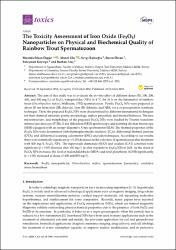| dc.contributor.author | Özgür, Mustafa Erkan | |
| dc.contributor.author | Ulu, Ahmet | |
| dc.contributor.author | Balcıoğlu, Sevgi | |
| dc.contributor.author | Özcan, İmren | |
| dc.contributor.author | Köytepe, Süleyman | |
| dc.contributor.author | Ateş, Burhan | |
| dc.date.accessioned | 2021-06-07T08:00:07Z | |
| dc.date.available | 2021-06-07T08:00:07Z | |
| dc.date.issued | 2018 | en_US |
| dc.identifier.citation | Özgür, M., Ulu, A., Balcıoğlu, S., Özcan, I., Köytepe, S., & Ateş, B. (October 18, 2018). The Toxicity Assessment of Iron Oxide (Fe3O4) Nanoparticles on Physical and Biochemical Quality of Rainbow Trout Spermatozoon. Toxics, 6, 4, 62. | en_US |
| dc.identifier.issn | 2305-6304 | |
| dc.identifier.uri | https://doi.org/10.3390/toxics6040062 | |
| dc.identifier.uri | https://hdl.handle.net/20.500.12899/187 | |
| dc.description.abstract | The aim of this study was to evaluate the in vitro effect of different doses (50, 100, 200, 400, and 800 mg/L) of Fe3O4 nanoparticles (NPs) at 4 degrees C for 24 h on the kinematics of rainbow trout (Oncorhynchus mykiss, Walbaum, 1792) spermatozoon. Firstly, Fe3O4 NPs were prepared at about 30 nm from Iron (III) chloride, Iron (II) chloride, and NH3 via a co-precipitation synthesis technique. Then, the prepared Fe3O4 NPs were characterized by different instrumental techniques for their chemical structure, purity, morphology, surface properties, and thermal behavior. The size, microstructure, and morphology of the prepared Fe3O4 NPs were studied by Fourier transform infrared spectroscopy (FTIR), X-ray diffraction (XRD) spectroscopy, and scanning electron microscopy (SEM) equipped with an energy-dispersive X-ray spectrometer (EDS). The thermal properties of the Fe3O4 NPs were determined with thermogravimetric analysis (TGA), differential thermal analysis (DTA), and differential scanning calorimeter (DSC) analysis techniques. According to our results, there were statistically significant (p < 0.05) decreases in the velocities of spermatozoon after treatment with 400 mg/L Fe3O4 NPs. The superoxide dismutase (SOD) and catalase (CAT) activities were significant (p < 0.05) decrease after 100 mg/L in after exposure to Fe3O4 NPs in 24 h. As the doses of Fe3O4 NPs increases, the level of malondialdehyde (MDA) and total glutathione (tGSH) significantly (p < 0.05) increased at doses of 400 and 800 mg/L. | en_US |
| dc.language.iso | eng | en_US |
| dc.publisher | Multidisciplinary Digital Publishing Institute (MDPI) | en_US |
| dc.relation.isversionof | 10.3390/toxics6040062 | en_US |
| dc.rights | info:eu-repo/semantics/openAccess | en_US |
| dc.subject | Fe3O4 nanoparticles | en_US |
| dc.subject | Oncorhynchus mykiss | en_US |
| dc.subject | Oxidative stress biomarkers | en_US |
| dc.subject | Spermatozoon kinematics | en_US |
| dc.title | The toxicity assessment of iron oxide (Fe3O4) nanoparticles on physical and biochemical quality of rainbow trout spermatozoon | en_US |
| dc.type | article | en_US |
| dc.authorid | 0000-0002-2966-9627 | en_US |
| dc.department | MTÖ Üniversitesi, Doğanşehir Vahap Küçük Meslek Yüksekokulu, Su Ürünleri Bölümü | en_US |
| dc.contributor.institutionauthor | Özgür, Mustafa Erkan | |
| dc.identifier.volume | 6 | en_US |
| dc.identifier.issue | 418 | en_US |
| dc.identifier.startpage | 1 | en_US |
| dc.identifier.endpage | 13 | en_US |
| dc.relation.journal | Toxics | en_US |
| dc.relation.publicationcategory | Makale - Uluslararası Hakemli Dergi - Kurum Öğretim Elemanı | en_US |


















